中西方翻译理论汇总共27页
- 格式:ppt
- 大小:4.16 MB
- 文档页数:27
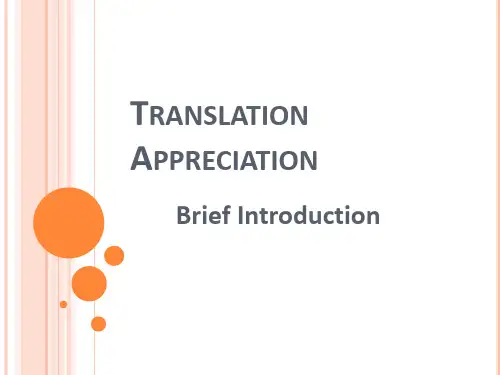
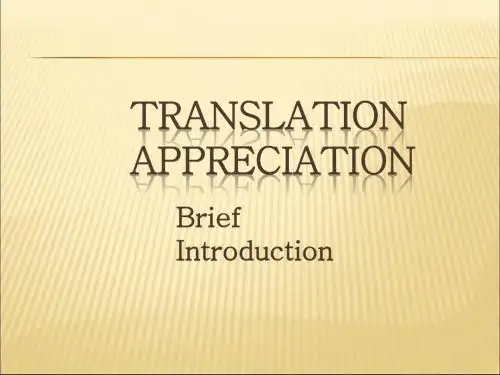
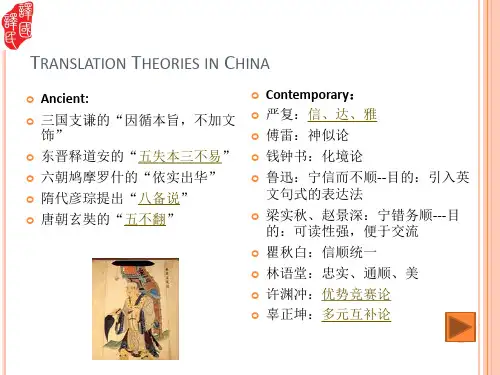

谭载喜在介绍西方翻译理论时,将西方翻译理论分为四大学派:1布拉格学派;2 伦敦派; 3 美国结构派;4 交际理论派。
而柯平在《西方翻译理论浅析》一文中介绍了六大学派:1.语言学派;2 交际学派;3 美国翻译研讨班学派;4文学-文化学派;5结构学派;6社会符号学派。
下文将一一介绍。
一、布拉格学派该学派的创始人为马希修斯(Vilem Mathesius)、特鲁贝斯科伊(Nikolay S. Trubetskoy)和雅可布森(Roman Jakobson)。
主要成员有雅可布森、列维、维内等重要的翻译理论家。
这一学派的主要论点为:(1)翻译必须考虑语言的各种功能,包括认识功能、表达功能和工具功能等;(2)翻译必须重视语言的比较,包括语义、语法、语音、语言风格以及文学体裁的比较。
布拉格学派最有影响的翻译理论家是罗曼·雅可布森。
他原籍俄国,后移居捷克;二战时迁至美国,加入美籍。
作为学派的创始人之一,他对翻译理论的贡献主要体现在《论翻译的语言学问题》(On Linguistic Aspects of Translation)之中。
文章从语言学的角度,对翻译的重要性、语言和翻译的关系以及存在的问题给出精辟的论述。
自1959年发表后,此文一直被西方理论界奉为翻译研究的经典之一。
雅可布森的论述主要有五点:(1)翻译分为三类:语内翻译(intralingual translation)、语际翻译(interlingual translation)和符际翻译(intersemiotic translation)。
所谓语内翻译,是指在同一语言内用一些语言符号去解释另一些语言符号,即通常的“改变说法”(rewording)。
所谓语际翻译,是指在两种语言之间即用一种语言的符号去解释另一种语言的符号,即严格意义上的翻译。
所谓符际翻译,是指用非语言符号系统解释语言符号,或用语言符号解释非语言符号,比如把旗语或手势变成言语表达。
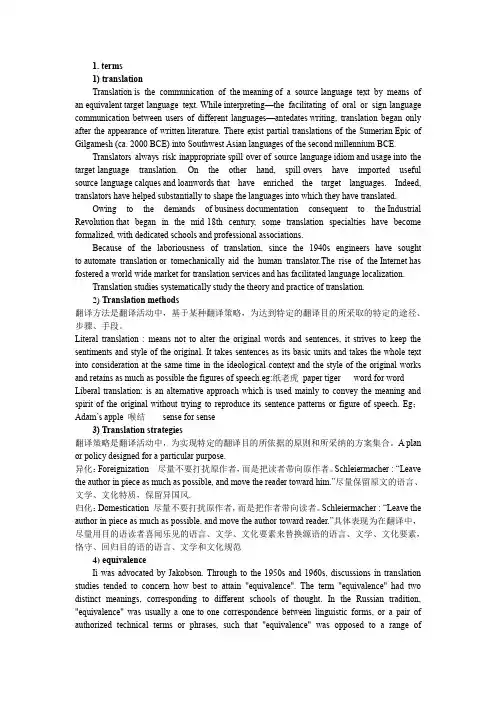
1. terms1) translationTranslation is the communication of the meaning of a source-language text by means of an equivalent target-language text. While interpreting—the facilitating of oral or sign-language communication between users of different languages—antedates writing, translation began only after the appearance of written literature. There exist partial translations of the Sumerian Epic of Gilgamesh (ca. 2000 BCE) into Southwest Asian languages of the second millennium BCE.Translators always risk inappropriate spill-over of source-language idiom and usage into the target-languagetranslation. On the other hand, spill-overs have imported useful source-language calques and loanwords that have enriched the target languages. Indeed, translators have helped substantially to shape the languages into which they have translated.Owing to the demands of business documentation consequent to the Industrial Revolution that began in the mid-18th century, some translation specialties have become formalized, with dedicated schools and professional associations.Because of the laboriousness of translation, since the 1940s engineers have sought to automate translation or tomechanically aid the human translator.The rise of the Internet has fostered a world-wide market for translation services and has facilitated language localization.Translation studies systematically study the theory and practice of translation.2)Translation methods翻译方法是翻译活动中,基于某种翻译策略,为达到特定的翻译目的所采取的特定的途径、步骤、手段。
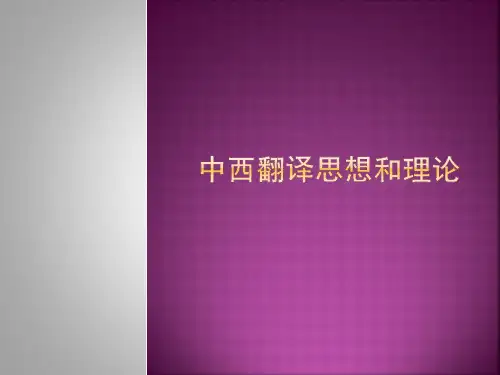
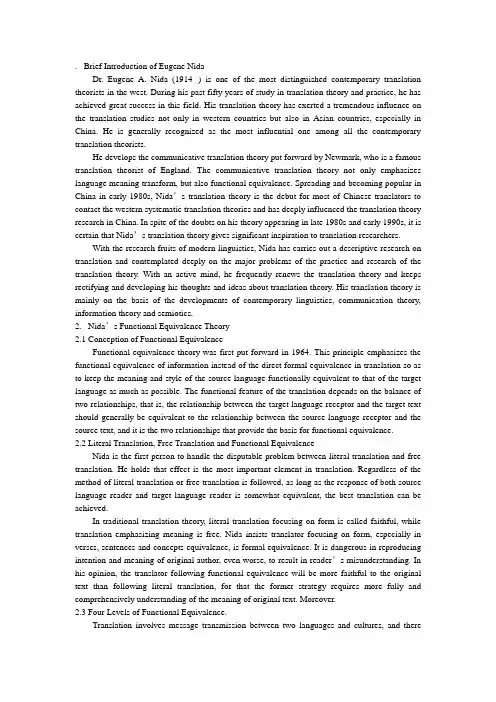
. Brief Introduction of Eugene NidaDr. Eugene A. Nida (1914--) is one of the most distinguished contemporary translation theorists in the west. During his past fifty years of study in translation theory and practice, he has achieved great success in this field. His translation theory has exerted a tremendous influence on the translation studies not only in western countries but also in Asian countries, especially in China. He is generally recognized as the most influential one among all the contemporary translation theorists.He develops the communicative translation theory put forward by Newmark, who is a famous translation theorist of England. The communicative translation theory not only emphasizes language meaning transform, but also functional equivalence. Spreading and becoming popular in China in early 1980s, Nida’s translation theory is the debut for most of Chinese translators to contact the western systematic translation theories and has deeply influenced the translation theory research in China. In spite of the doubts on his theory appearing in late 1980s and early 1990s, it is certain that Nida’s translation theory gives significant inspiration to translation researchers.With the research fruits of modern linguistics, Nida has carries out a descriptive research on translation and contemplated deeply on the major problems of the practice and research of the translation theory. With an active mind, he frequently renews the translation theory and keeps rectifying and developing his thoughts and ideas about translation theory. His translation theory is mainly on the basis of the developments of contemporary linguistics, communication theory, information theory and semiotics.2. Nida’s Functional Equivalence Theory2.1 Conception of Functional EquivalenceFunctional equivalence theory was first put forward in 1964. This principle emphasizes the functional equivalence of information instead of the direct formal equivalence in translation so as to keep the meaning and style of the source language functionally equivalent to that of the target language as much as possible. The functional feature of the translation depends on the balance of two relationships, that is, the relationship between the target language receptor and the target text should generally be equivalent to the relationship between the source language receptor and the source text, and it is the two relationships that provide the basis for functional equivalence.2.2 Literal Translation, Free Translation and Functional EquivalenceNida is the first person to handle the disputable problem between literal translation and free translation. He holds that effect is the most important element in translation. Regardless of the method of literal translation or free translation is followed, as long as the response of both source language reader and target language reader is somewhat equivalent, the best translation can be achieved.In traditional translation theory, literal translation focusing on form is called faithful, while translation emphasizing meaning is free. Nida insists translator focusing on form, especially in verses, sentences and concepts equivalence, is formal equivalence. It is dangerous in reproducing intention and meaning of original author, even worse, to result in reader’s misunderstanding. In his opinion, the translator following functional equivalence will be more faithful to the original text than following literal translation, for that the former strategy requires more fully and comprehensively understanding of the meaning of original text. Moreover.2.3 Four Levels of Functional Equivalence.Translation involves message transmission between two languages and cultures, and therestill exists lots of similarity among different language cultures, which is the objective basis. Because of the different location, history, cultural ground and education level, it is hard to be objective. The definition of translation Nida proposed shows that translation is not only related to equivalence of lexical meaning, but also the equivalence of text connotation and style, message translated in translation includes surface lexical message and deep cultural message. Functional equivalence includes four levels: lexical equivalence, sentence equivalence, passage equivalence and style equivalence.2.3.1 Lexical equivalenceThe meaning of a word lies in its usage in language. In translation practice, what confuse us is how to find the corresponding meaning in target language. Take Tension is building up as an example, tension and build up both have different explanations without consideration of context. Thus this sentence can be translated as several different editions:In English—Chinese translation, completely lexical equivalence lies in special terms and terminology, besides which there are five correspondences, word equivalence, synonymy, polysemy, lexical meaning overlap and zero equivalence.2.3.2 Sentence EquivalenceSentence equivalence is more complicated than lexical equivalence. In English- Chinese translation, singular and plural form is an important and evident problem. Plural meaning in Chinese is not expressed with any evident plural form, which is different in English. Moreover, for different target language, tender, number and tense should be taken into consideration in translation. Thus, translator should be clear about whether such a sentence grammar exists in the target language or not, and be clear about the frequency of such sentence grammar.2.3.3 Passage EquivalenceIn order to achieve passage equivalence, language is not the unique element we should consider, what we should also take into consideration is how the language represents meaning and performs its function in a specific context. Passage equivalence consists of three parts, passage context, scene context and cultural context. Passage context lies in analysis of language, which aims to judge the meaning of words and semantic units in original text, and is based on analysis of meaning and connotation of the passage. Scene context includes the concrete person and things involved in communication, the channel of communication, the relationship among participants and mental emotions.3. ConclusionNida’s translation theory has been popular in the world for nearly sixty years and it has become an indispensable part of translation studies. Holding a panoramic view of all the important points in Nida’s theory, we can conclude that the essence of his theory is that he insists the translator should pay prior attention to the meaning of the source text and should not be curbed by the expression form of the source text. Moreover, Nida’s translation theory is a genuine breakthrough and its influence and contribution to the translation field cannot be underestimated, and it dose render us a profound enlightenment that the excellent translation comes from practice.Nida has been a pioneer in the fields of translation theory and linguistics.His Ph.D. dissertation, A Synopsis of English Syntax, was the first full-scale analysis of a major language according to the "immediate-constituent" theory. His most notable contribution to translation theory is Dynamic Equivalence, also known as Functional Equivalence. For more information, see "Dynamic and formal equivalence." Nida also developed the"componential-analysis" technique, which split words into their components to help determine equivalence in translation (e.g. "bachelor" = male + unmarried). This is, perhaps, not the best example of the technique, though it is the most well-known.Nida's dynamic-equivalence theory is often held in opposition to the views of philologists who maintain that an understanding of the source text(ST) can be achieved by assessing theinter-animation of words on the page, and that meaning is self-contained within the text (i.e. much more focused on achieving semantic equivalence).This theory, along with other theories of correspondence in translating, are elaborated in his essay Principles of Correspondence,[6]where Nida begins by asserting that given that “no two languages are identical, either in the meanings given to corresponding symbols or in the ways in which symbols are arranged in phrases and sentences, it stands to reason that there can be no absolute correspondence between languages. Hence, there can be no fully exact translations.”[7] While the impact of a translation may be close to the original, there can be no identity in detail.Nida then sets forth the differences in translation, as he would account for it, within three basic factors: (1) The nature of the message: in some messages the content is of primary consideration, and in others the form must be given a higher priority. (2) The purpose of the author and of the translator: to give information on both form and content; to aim at full intelligibility of the reader so he/she may understand the full implications of the message; for imperative purposes that aim at not just understanding the translation but also at ensuring no misunderstanding of the translation. (3) The type of audience: prospective audiences differ both in decoding ability and in potential interest.Nida brings in the reminder that while there are no such things as “identical equivalents” in translating, what one must in translating seek to do is find the “closest natural equivalent”. Here he identifies two basic orientations in translating based on two different types of equivalence: Formal Equivalence (F-E) and Dynamic Equivalence (D-E).F-E focuses attention on the message itself, in both form and content. Such translations then would be concerned with such correspondences as poetry to poetry, sentence to sentence, and concept to concept. Such a formal orientation that typifies this type of structural equivalence is called a “gloss translation” in which the translator aims at reproducing as literally and meaningfully as possible the form and content of the original.The principles governing an F-E translation would then be: reproduction of grammatical units; consistency in word usage; and meanings in terms of the source context.D-E on the other hand aims at complete “naturalness” of expression. A D-E translation is directed primarily towards equivalence of response rather than equivalence of form. The relationship between the target language receptor and message should be substantially the same as that which existed between the original (source language) receptors and the message.The principles governing a D-E translation then would be: conformance of a translation to the receptor language and culture as a whole; and the translation must be in accordance with the语言学派翻译理论奥古斯丁发展了亚里士多德的“符号”理论,提出了语言符号的“能指”、“所指”和译者“判断”的三角关系,开创了西方翻译理论的语言学传统。

翻译有哪些理论翻译学中的理论有很多,以下是其中的一些主要理论:1.等效理论(Equivalence Theory):由Eugene Nida和Charles Taber于1960年提出。
该理论认为翻译的目标是在不同语言之间传达与源文本相等或相似的意义。
它强调翻译的等级和程度,分为准确传递(充分等效)、部分传递(偏远等效)和恢复信息(零等效)。
2.功能对等理论(Functional Equivalence Theory):由Christiane Nord于1991年提出。
该理论认为翻译的目标是根据目标语言和文化的读者需求,在功能上等效于源文本。
它强调翻译的目的是满足读者对论述、表述和信息的期望,并做出相应调整。
3.文化翻译理论(Cultural Translation Theory):由AndréLefevere于1992年提出。
该理论认为翻译是一种文化间的传递和变革过程,强调翻译的文化因素对于意义的建构和解读至关重要。
它探讨了源文本和目标文本之间的文化差异,并提出了译者作为文化中介者的角色。
4.再现理论(Relevance Theory):由Dan Sperber和Deirdre Wilson于1986年提出。
该理论认为翻译的目标是传递有效沟通所需的信息,并尽可能减少读者的认知努力。
它强调翻译要遵循言语交际原则,提供最相关和最明确的信息,以确保双方的理解和交流。
5.干扰理论(Interference Theory):源于歧义和误会的语言干扰现象。
干扰理论认为翻译是在源语言和目标语言之间进行的,源语言结构和表达方式会对译文产生不同程度的影响。
干扰理论研究译者如何解决干扰问题,以确保翻译的准确性和流畅性。
6.社会文化理论(Sociocultural Theory):由Lev Vygotsky于20世纪初提出。
社会文化理论认为翻译是一种社会和文化实践,翻译活动受到社会环境和文化背景的影响。
它研究翻译与社会和文化因素之间的相互关系,强调译者的角色和社会文化认知对翻译的重要性。
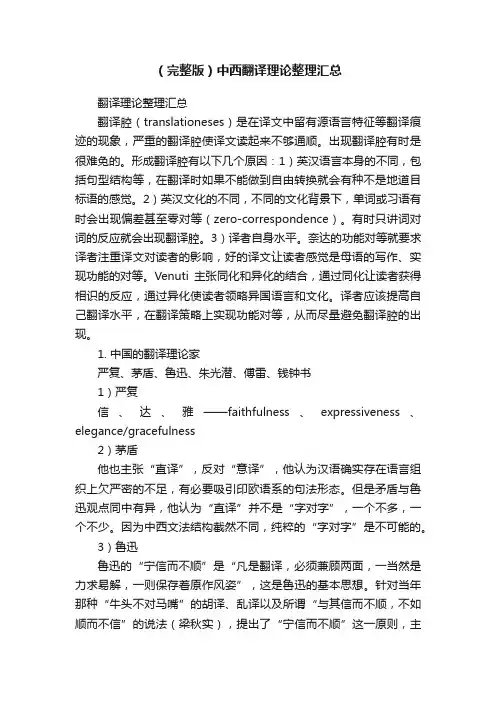
(完整版)中西翻译理论整理汇总翻译理论整理汇总翻译腔(translationeses)是在译文中留有源语言特征等翻译痕迹的现象,严重的翻译腔使译文读起来不够通顺。
出现翻译腔有时是很难免的。
形成翻译腔有以下几个原因:1)英汉语言本身的不同,包括句型结构等,在翻译时如果不能做到自由转换就会有种不是地道目标语的感觉。
2)英汉文化的不同,不同的文化背景下,单词或习语有时会出现偏差甚至零对等(zero-correspondence)。
有时只讲词对词的反应就会出现翻译腔。
3)译者自身水平。
奈达的功能对等就要求译者注重译文对读者的影响,好的译文让读者感觉是母语的写作、实现功能的对等。
Venuti主张同化和异化的结合,通过同化让读者获得相识的反应,通过异化使读者领略异国语言和文化。
译者应该提高自己翻译水平,在翻译策略上实现功能对等,从而尽量避免翻译腔的出现。
1. 中国的翻译理论家严复、茅盾、鲁迅、朱光潜、傅雷、钱钟书1)严复信、达、雅——faithfulness、expressiveness、elegance/gracefulness2)茅盾他也主张“直译”,反对“意译”,他认为汉语确实存在语言组织上欠严密的不足,有必要吸引印欧语系的句法形态。
但是矛盾与鲁迅观点同中有异,他认为“直译”并不是“字对字”,一个不多,一个不少。
因为中西文法结构截然不同,纯粹的“字对字”是不可能的。
3)鲁迅鲁迅的“宁信而不顺”是“凡是翻译,必须兼顾两面,一当然是力求易解,一则保存着原作风姿”,这是鲁迅的基本思想。
针对当年那种“牛头不对马嘴”的胡译、乱译以及所谓“与其信而不顺,不如顺而不信”的说法(梁秋实),提出了“宁信而不顺”这一原则,主张直译,以照顾输入新表现法和保持原作的风貌。
他还认为,翻译一要“移情”、“益志”,译文要有“异国情调”,二要“输入新的表现法”,以改进中文的文法,在当时主要表现为改进白话文。
必须强调的是,鲁迅其实是主张翻译要通顺,又要忠实的。
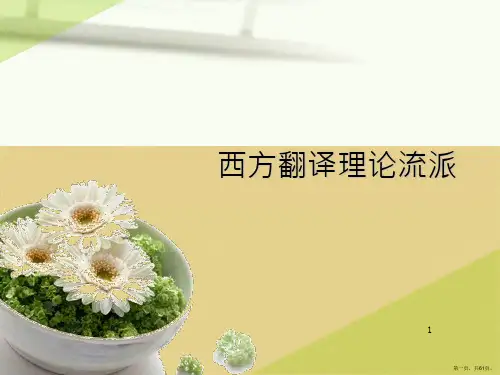
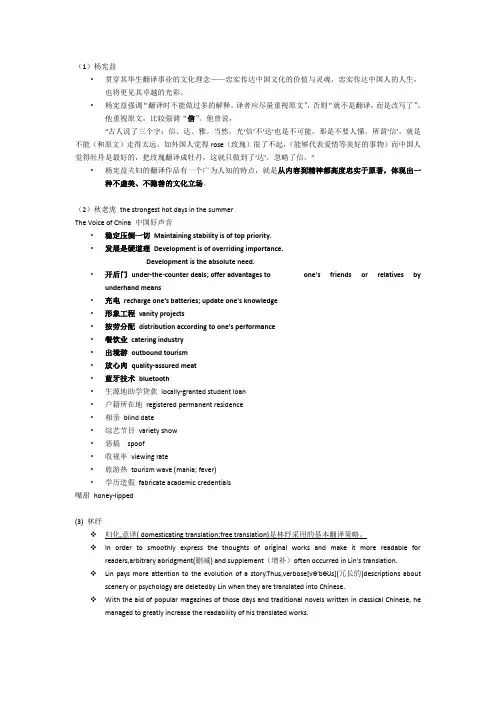
(1)杨宪益•贯穿其毕生翻译事业的文化理念——忠实传达中国文化的价值与灵魂,忠实传达中国人的人生,也将更见其卓越的光彩。
•杨宪益强调“翻译时不能做过多的解释。
译者应尽量重视原文”,否则“就不是翻译,而是改写了”。
他重视原文,比较强调“信”。
他曾说,“古人说了三个字:信、达、雅。
当然,光‘信’不‘达’也是不可能,那是不要人懂。
所谓‘信’,就是不能(和原文)走得太远。
如外国人觉得rose(玫瑰)很了不起,(能够代表爱情等美好的事物)而中国人觉得牡丹是最好的,把玫瑰翻译成牡丹,这就只做到了‘达’,忽略了信。
”•杨宪益夫妇的翻译作品有一个广为人知的特点,就是从内容到精神都高度忠实于原著,体现出一种不虚美、不隐善的文化立场。
(2)秋老虎the strongest hot days in the summerThe Voice of China 中国好声音•稳定压倒一切Maintaining stability is of top priority.•发展是硬道理Development is of overriding importance.Development is the absolute need.•开后门under-the-counter deals; offer advantages to one's friends or relatives by underhand means•充电recharge one’s batteries; update one's knowledge•形象工程vanity projects•按劳分配distribution according to one's performance•餐饮业catering industry•出境游outbound tourism•放心肉quality-assured meat•蓝牙技术bluetooth•生源地助学贷款locally-granted student loan•户籍所在地registered permanent residence•相亲blind date•综艺节目variety show•恶搞spoof•收视率viewing rate•旅游热tourism wave (mania; fever)•学历造假fabricate academic credentials嘴甜honey-lipped(3) 林纾❖归化,意译( domesticating translation;free translation)是林纾采用的基本翻译策略。